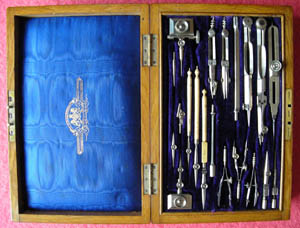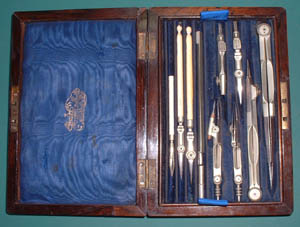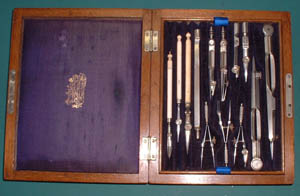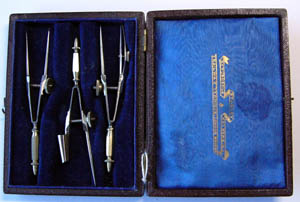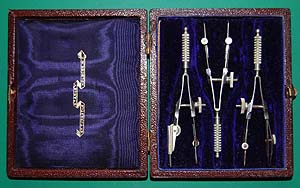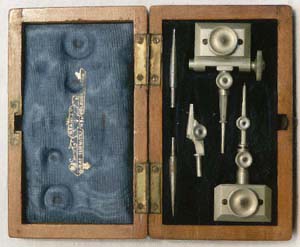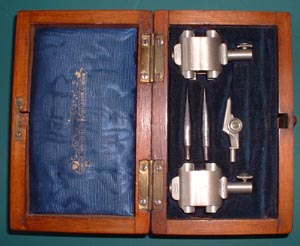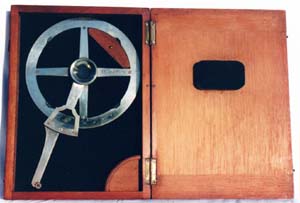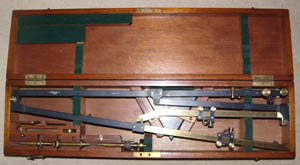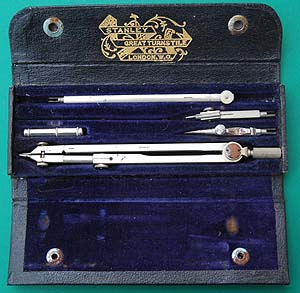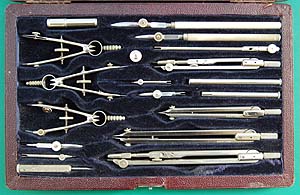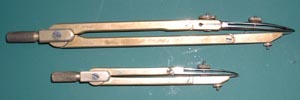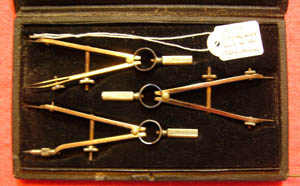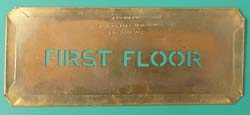












William Ford Stanley (1829-1909) founded his firm in 1853, making drawing and surveying instruments and in 1866 published the first edition of his Treatise on Drawing Instruments. This became the standard work on the subject and eight editions were produced up to 1925. The head office and works were latterly at Avery Hill Road, New Eltham, London SE9. They became part of the Sime Darby Group c1977 and were finally liquidated in 1999.

A 10 inch, electrum bound, three tier, oak case of Stanley instruments of the highest quality, probably circa 1880. The upper tray contains a full set of instruments in electrum and ivory with, additionally, beam compass fittings and a proportional divider. The second tray contains an ivory sector, ivory rule and ivory protractor. The bottom of the box contains a set of Stanley vulcanite French curves. The non-original six inch compass shown in the picture has since been replaced with a Stanley one. The compass fittings include two extension bars and both type A and type B points.
A Stanley, rosewood veneered, box of nickel silver instruments. This would have been one of the cheaper boxes in Stanley's range since the instruments have plain points and do not have knee joints. It dates from the nineteenth century.
A larger, eight inch mahogany box of nickel silver instruments dating from about 1900. Although they still have plain points and are without knee joints these instruments are of quite a good quality. The case also contains an ivory scale rule and an ivory parallel rule.
There is another eight inch box of Stanley Instruments, an oak one, shown on the Home page.
A set of Stanley drawing instruments from c1900. They are mainly made of electrum. The pen handles and rule are ivory, and the case is covered in brown leather.
Early pattern spring bows by Stanley, probably late nineteenth century.
A set of Stanley spring bows with needle points dating from about 1900
Stanley railway curves. The set originally contained fifty pear wood curves of which only forty remain.
Stanley made a number of different types of beam compass fittings. These are their Swiss pattern ones. Besides the two plain points and pen and pencil inserts, there is a "type A" spring loaded point seen in the trammel with the adjusting screw.
Stanley “La Trobe patent” beam compass fittings in a mahogany case.
This view shows the Stanley version of the vernier protractor, made of nickel-silver or electrum. About 1900.
A Stanley ‘Improved’ 26 inch pantograph in its fitted case.
British Empire pattern six inch compass half set in a leatherette covered wallet case probably early 1920s. This pattern of instruments was a standard one manufactured by several firms, also including W H Harling and A G Thornton.
“Stanley London” flat pattern set, date stamped for 1947 on the compass. I am certain that these instruments were actually made by A G Thornton as they are identical to that firm’s Minerva series
"Stanley" flat pattern compasses, which were actually made by J J Threadwell & Sons. Identical instruments were also retailed by Charles Baker, Cooke Troughton & Simms, and Threadwell themselves.
A set of three spring bows of the C spring type said to be Stanley and to date from 1933. Stanley bought in cheaper instruments from other makers for sale for student use.
One of a set of 23 brass architects stencils, stamped W F Stanley, Gt Turnstile, Holborn, London WC. The stencils are: 8mm - SECTION THROUGH, FIRST FLOOR, SECOND FLOOR, ROOF PLAN, ELEVATION, GROUND PLAN, PLAN, and 4mm - SCALE FEET TO INCH, MORNING ROOM, DRAWING ROOM, LADIES, GENTLEMEN, BATH, W.C., COOK, STORE, COALS, LARDER, KITCHEN, DINING ROOM, BED ROOM, LIBRARY, SCULLERY.





A Stanley tubular beam compass with three pull out sections. It measures 13 inches closed and 37 inches fully extended. At the left end is a micrometer screw for fine adjustment. There are pen and pencil inserts, a type B point and one short and two long plain points (one of the latter being an addition). It probably dates from the late nineteenth century. In the 1900 edition of his book, Stanley said that they were not much in demand by then as they were not very steady. The case is Morocco covered and lined with silk and velvet.
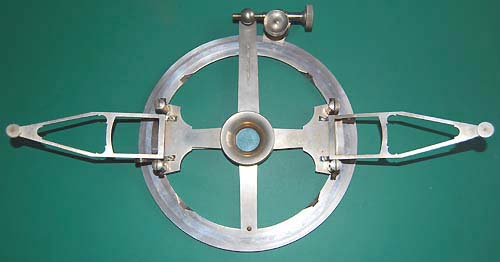
Six inch diameter folding arm protractor signed Stanley, London dating from about 1900. Made of electrum, it has an inset silver scale and silver vernier scales on both arms reading to one minute of arc. For fine adjustment it has a clamp and tangent screw. These were typically used for plotting theodolite readings. It has a mahogany case.

Triangular section scale rule and case. The scales are: inches, 1/2; inches 1/16ths, 3 in; 1 1/2, 3/4.
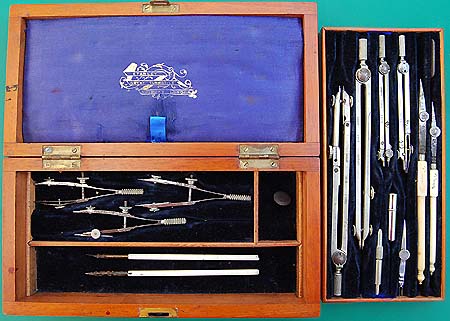
W F Stanley British Empire pattern set made for the government in 1919. All the instruments in the upper tray are dated 1919, as is the case. They all also have individual serial numbers and the case has serial no. 4960. The instruments are electrum and steel and the pen handles are ivory.. The two crow quill pens in the base are probably not original. This is a very early example of a British Empire series set. The spring bows are the steel type rather than the ‘C’ spring type usually associated with this pattern
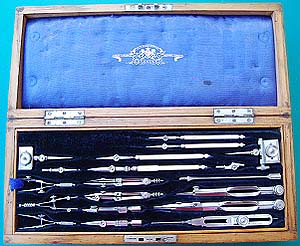
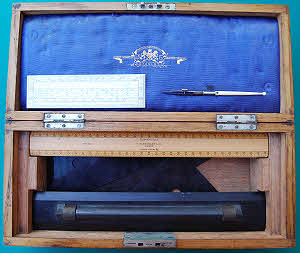
13” Stanley oak case (actually 14.5” long) containing a set of electrum and ivory drawing instruments dating from ca. 1880. The instruments in the tray comprise a six inch compass half set, a hair divider, two bow compasses, three spring bows, three ruling pens, a pricker, proportional dividers, and a set of beam compass fittings. Supported below the tray are five boxwood scales and a 12 inch rolling parallel rule. In the bottom of the case there are three vulcanite set squares (45, 60 and 67½ degree), an ivory rectangular protractor, and another, non-original, ruling pen.
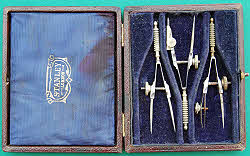
My third set of Stanley spring bows, mid-20th century but still the traditional English pattern in a faux Morocco case lined with silk and velvet.
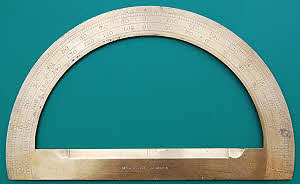
Six inch brass protractor signed Stanley London
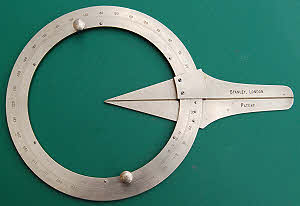
Stanley reading to centre protractor, six inch diameter, The inner circle rotates within the outer and one arm and pointer moves with it, There is a vernier reading to one minute. This was patented by William Ford Stanley in 1885, no. 4530.

A Stanley telescopic turnabout compass. This has now been placed in a case that is missing this item, see below.
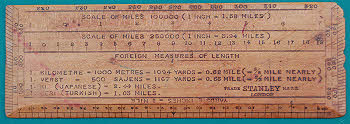
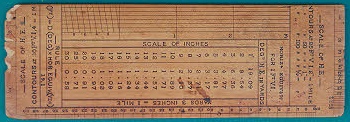
New service protractor by W F Stanley dating from about 1900. This example has been cut down along the upper edge. It combines the function of a protractor with various map scales, diagonal scales and a table of horizontal equivalents.
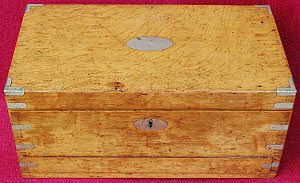
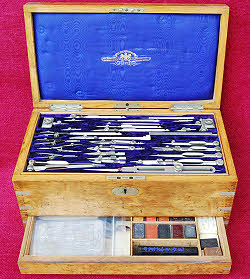
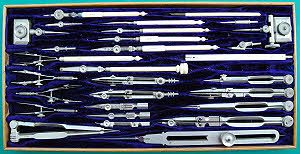
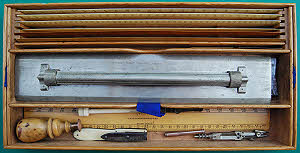
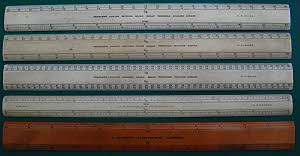
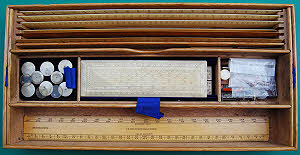

The series of eight pictures above show the Stanley magazine case in my collection. It is approximately 14.5 x 7.8 x 6.8 inches high and has two trays with a space under and a spring loaded drawer. The case is oak, bound with electrum, and lined with blue silk and velvet. It is fitted with a Hobbs lock. The upper tray is full of electrum and ivory drawing instruments that include, besides the usual compasses and pens found in the smaller sets, a triangular divider, Swiss pattern beam compass fittings, a nine inch proportional divider, a road pen, a dotted line pen, a tracer and a pen fitted with an index wheel. The large compass is also a special one normally only found in the larger sets, that has two detachable legs and both type A and type B needle points. It is missing the second extension bar.
There are two views of the second tray, the second being with the solid electrum rolling parallel rule and some spurious items removed. The case was offered by Stanley (Catalogue number K2202 in the 1912 catalogue) with either six chain scales and six offsets or six mechanical engineer’s/architect’s scales. There are three, possibly four, of the original scales remaining. They are ivory and for mechanical engineers/architects. Three are signed Stanley. The fourth is signed Reynolds but faintly discernible under is an erased Stanley signature! All are stamped with the original owner’s name. The fifth scale in the illustration is a boxwood scale by J Archbutt that dates from 1838 - 64 and is clearly not original to this case. There are also two later boxwood scales, one by Stanley and one by Reynolds. Two offsets by Gray & Selby of Nottingham are additions and irrelevant as there are no matching scales. The ivory sector and the four line ivory protractor are unsigned and possibly replacements for the originals. The eight line ivory protractor is signed Elliott Bros London and clearly an addition. Some of the electrum drawing pins and the horn centres are probably original items in the case.
Under the two trays is a space for set squares, protractors and French curves. Apart from two large (45 and 60 degree) celluloid set squares that could be original (although they were catalogued as Vulcanite) the original items are all lost. There are two celluloid protractors and an angle template, all from different vendors, that are later additions.
The drawer contains a full set of ten Winsor & Newton watercolour cakes with little sign of use. These would be original as is probably the stick of Chinese ink. There is a sizeable collection of watercolour brushes and there are two rubber erasers that are probably from the first half of the 20th century as well as two additional watercolour cakes. The rectangular space that should house a china palette is now filled with some of the added items. Particularly interesting are the two erasing knives made by F Morgan of Sheffield and the fibre glass eraser, similar to one in the A G Thornton catalogue of 1916.
Returning to the second drawer there are a quill cutter, described on another page, and a hatchet (wafer) seal with a very yellowed ivory handle, neither of which has any relevance to this set, as well as an added dotted line pen and pencil bow compass.
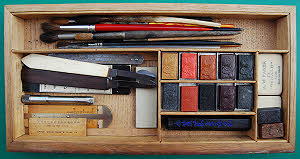
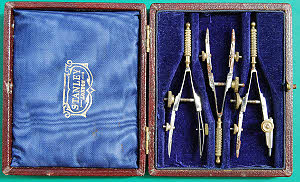
My 4th set of Stanley spring bows. These have type B points. Unusually they have brass handles and thumb nuts suggesting they date to the period of metal shortages in the 1940s and the shortage of nickel alloys.
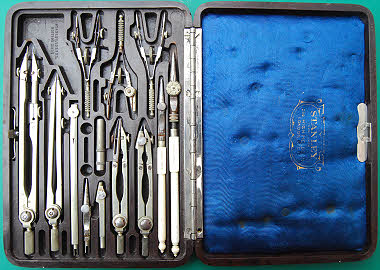
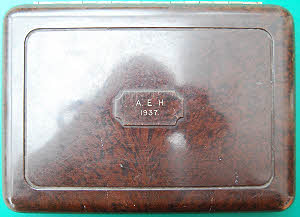
Stanley ‘Perma’ (Bakelite) cased set of ‘Government Standard Pattern’ drawing instruments made of electrum. The larger pen is to Stanley’s patent design of cross joint nib, released for cleaning by unscrewing the knurled nut at the base of the nib. It also has a line width setting scale on the thumb wheel. The other pen has a hinged nib. It is dated 1937 below the original owner’s initials.

Stanley drop bow (rotating) compass, probably dating from the 1950s. It is electrum, steel and stainless steel.

An unusual Stanley 12” parallel rule dating from ca,1917. It is made of opaque white
celluloid and gunmetal an appeared in the 1912 and 1931 catalogues.
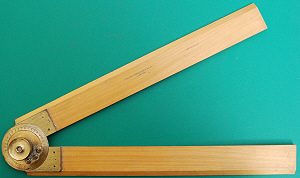
Stanley 12 inch isograph, boxwood & brass. Unlike the six inch one that relies on
friction to hold the angle set, the twelve inch one has a central locking thumb screw.
These were eventually superceded by the adjustable set square.
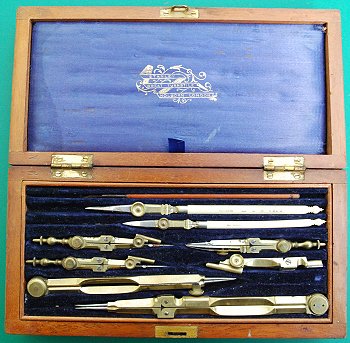
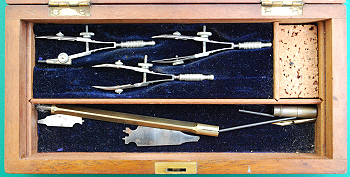
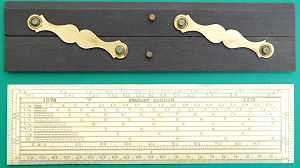
This Stanley set was made for the UK government in 1915, serial no. 1249. The metal
instruments are brass. Except for the spring bows and protractor the instruments
were not made by Stanley but by other makers (Harling, Thornton, Hughes and Cousell).
However all are dated 1915, marked with the broad arrow, and individually serial
numbered.
Why so many different makers? A possible explanation for this and other sets to this
government specification: all the items in this set are clearly original. In each
case with these sets the box and spring bows were made by the maker whose name is
on the lid. The other instruments were sourced separately and added on receipt by
the government.




Ivory 4 fold rule signed Stanley Great Turnstile Holborn London. On the inner faces
are a 24 inch X 10ths rule and four ‘architect’s’ scales on the bevelled inner edges
for 16, 24, 20 and 30 divisions to the inch. On the outer faces are tables of conversion
factors of many types such as kg to lbs, or cu.ft. to gallons and there are also
some formulae. These and one long table have yet to be deciphered as these and the
abbreviations and letters used for the formulae are not identified on the rule. On
the outer edges of the rule there are a metric (cm and mm) scale and a foot scale
divided into tenths and hundredths.
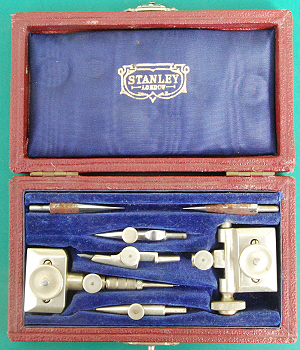
This is actually my third set of Stanley Swiss pattern beam compass fittings. Like
the first it has ink & pencil lead fittings, types A and B points, and two plain
points but there are detail differences:
- The thumb wheels are simplified
- The upper part of the type A point fitting is knurled whilst the older one is faceted
- The case is covered in red leatherette instead of being polished wood
This set probably dates from the 1950s
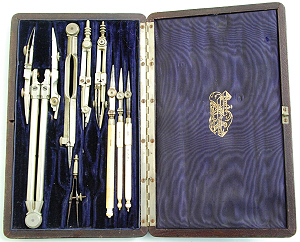
I obtained this case,almost empty, soon after I started collecting in the hope that
I might eventually find the telescopic, turn-about compass to fit it. Fortunately
I did (the compass can be seen on its own further up this page) and I then set about
populating the other spaces with Stanley instruments. The spring bow is unmarked
and probably not Stanley however so I still need to find a set of small-size Stanley
spring bows to fit it.
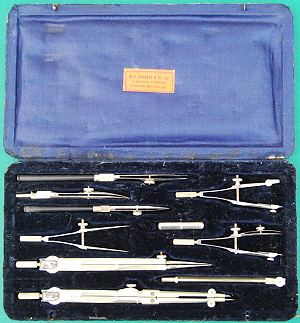
W F Stanley set of student’s instruments made in Germany. The label reads W F Stanley
& Co Ld, 13 Railway Approach, London Bridge SE. It can be dated to between 1900 and
1914 and appears in the 1912 catalogue as item K2252. The case is covered in black
leather and is bolt fastening. The divider and compass both have self centring heads.
This set was almost certainly made by Schoener.

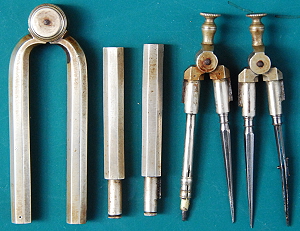
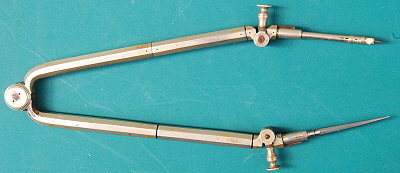

Stanley pillar compass with two extension bars and signed in script.
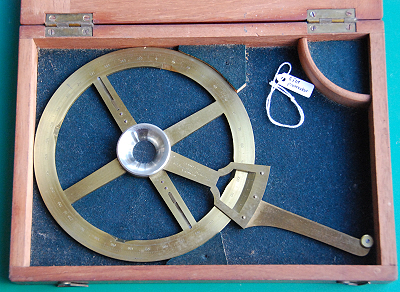
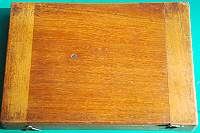
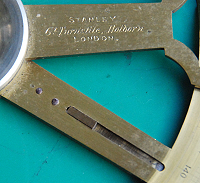

Stanley, Gt. Turnstile, Holborn, London six inch brass Vernier protractor. This is
a rare variant. Instead of the usual four fixed locating pins, this one has two spring-loaded
ones that can be seen in more detail in the two lower pictures. To push the pins
into the paper the brass sliders have to be slid outwards to the ends of the slots.





